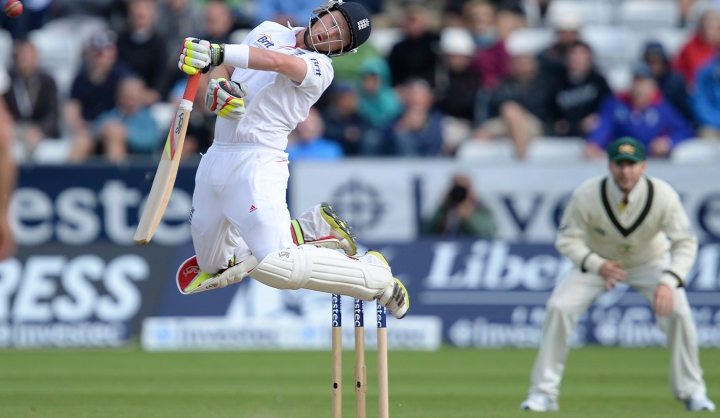Sport
Cricket: Five talking points after day three at Chester-le-Street

It’s amazing what can happen when two sides play mediocre cricket sprinkled with just a few moments of brilliance. The fourth Ashes Test at Chester-le-Street is delicately poised and a tantalising climax awaits over the next two days. ANTOINETTE MULLER picks five talking points from day five at Chester-le-Street.
The fourth Ashes Test between England and Australia is poised for the climax. Despite losing the toss, Australia impressed on day one while England’s top order continued to flap. The hosts were dismissed for 238 in their first innings with Nathan Lyon picking up four wickets. Australia responded with 270 all out, with Chris Rogers scoring a ton at the top of the order and Shane Watson chipping in with 68 after slotting in at number six. It wasn’t much of a surprise, as the first class scores at Durham have been pretty low this year.
England’s batting, though, left much to be desired, and a few questionable shot-selections in the second innings led to unnecessary dismissals. Ian Bell was impressive yet again, though, and notched up his 19th Test match ton, going to close of play unbeaten on 105. England ended the day on 233-5, 201 runs ahead. Beyond the runs and the actual cricket there was, as ever, plenty to talk about. We’ve picked five big talking points from day three.
England’s dodgy top order
There’s always something up with England’s batting, despite having some of the finest players in the game. If it’s not a mental block on how to play spin (hint: sweeping is not it) it’s the ability to be three wickets down all the time for no good reason. Against Australia so far, England has only managed to pass the 160-run mark without being fewer than five wickets down once and that was in the second innings of this Test. There were similar struggles against New Zealand earlier in the year. They managed to get to 167-4 in the second innings at Lord’s and manage to knuckle down convincingly at Headingly in the second innings, but that kind of inconsistency speaks volumes of a weak underbelly just waiting to be exposed. Perhaps England isn’t as good as it thinks it is.
What could have become of Ryan Harris if not for his injuries?
Ryan Harris has been quite sublime on this tour. He’s extracted bounce out of pitches which have been favourable for spin and every-so-often he has managed beautiful deliveries that send shivers down your spine. Harris’ ball to remove Joe Root on day three was one of those deliveries – the greatest tragedy for the big man. In his three-year career, he’s played just 14 Tests. He has taken 58 wickets in those games. Courtney Walsh took 14 Tests to reach 50 wickets, as did Shane Warne and Richard Hadlee. Harris has had a rough time with injury, and although he has stayed fit for three Tests in a row, one can’t help but feel concerned at the possibility of another injury blow. Even though he has given his all for his team, he looks ruined when walking around the field. He could have been so much more if it weren’t for his struggles.
Jonathan Trott’s slump
In the last six Tests Jonathan Trott has played, he averages just 32.75. It’s his second worst average for a season since he made his debut in 2009. During his previous slump, between December 2009 and March 2010, Trott averaged just 29.63 with a high score of 69. He managed two fifties and only managed to get into the 40s one other time. He was not once dismissed for a duck, though. Currently, Trott has scored three fifties from 16 May 2013 up until this Test, but he has been out for a duck twice – and he’s only been out for a duck five times in his entire career. He’s managed to get into the 40s three times, but is showing signs of weakness against the shorter ball. He’s often falling into the trap of going after it – perhaps out of sheer desperation of wanting to score runs.
Let’s talk about bad light, again
With a few minutes to go before the “official” cut off time for the day, Ian Bell made blinking movements with his eyes. His contact lenses were probably playing up again, but the umpires saw it as a time to have a go at checking the light. The two men on the field decided that it was time to take the players off owing to bad light. The light, according to the umpires, would have been so bad that it was putting the safety of the players at risk. Anybody who was watching the match on TV or at the ground would have been shaking their heads. The players didn’t want to go off, the paying public didn’t want to go off, but the umpires decided they should. It took just a few minutes for the players to re-emerge, perhaps the time it would take to bowl two overs of spin. Being an umpire can’t be easy. It’s a pretty thankless task and with no neutral umpires allowed in Tests these days, these men spend a lot of time away from home. The umpires are probably tired, annoyed and perhaps a little bit home sick. The case for non-neutral umpire certainly exists, especially considering that so many of them come from England and Australia – the current pool to pick from is pretty limited.
Was it right to pick Jackson Bird over Mitchell Starc?
Australia’s selection policy, otherwise known as rotation of players, has been most peculiar in the recent months. It seems, the better a bowler does, the more the chances are of him being dropped. Nathan Lyon suffered that fate during the first Test at Nottingham following his exploits in India and Mitchell Starc has been on the peculiar rotation list, too. Starc, although dubiously wayward in spells, took five wickets at Nottingham and got dropped. He took three wickets in Manchester and scored an unbeaten 66 and got dropped again. Jackson Bird has been the benefactor of the selection, but he’s not really impressed at Chester-le-Street. It is understandable that Australia might want to protect their younger bowlers, but when there is the chance to level the series, surely having your best eleven on the field is the only way to go? Hindsight is a wonderful thing, but there probably shouldn’t have been hindsight in the first place. Why Bird was selected ahead of Starc in the first place is somewhat curious.
Day three close of play summary:
England 238 (Alastair Cook 51, Jonathan Trott 49; Nathan Lyon 20-7-42, Jackson Bird 22-9-58-2) & 234-5 (Ian Bell 105*, Kevin Pietersen 44; Ryan Harris 20-1-74-3, Nathan Lyon 17-2-46-2)
Australia 270 (Chris Rogers 110, Shane Watson 68; Stuart Broad 24.3-7-71-5, Graeme Swann 18-5-48-2)
England lead by 202 runs with 5 wickets remaining. DM
Photo: England’s Ian Bell avoids a delivery from Australia’s Ryan Harris during their fourth Ashes test cricket match at the Riverside cricket ground, Chester-Le-Street, northern England August 11, 2013. REUTERS/Nigel Roddis


















 Become an Insider
Become an Insider